Exhibition dates: 15th November 2022 – 19th February 2023
Uta Barth (German, b. 1958)
Sundial (07.4)
2007
Chromogenic prints
Image (each): 76.2 x 71.7cm
Snite Museum of Art, University of Notre Dame, Humana Foundation Endowment for American Art
© Uta Barth
“Look beyond the facts
and you may discover,
there are new facts, that upon
careful examination
are not facts but assumptions.
The human eye is prejudiced.”
Drager Meurtant
Many thankx to the J. Paul Getty Museum for allowing me to publish the photographs in the posting. Please click on the photographs for a larger version of the image.
“To photograph in my home is a matter of convenience but it’s a way of saying that vision happens everywhere. Working with what’s around me all the time is to drive home that point and to get people to think about what is around them all the time, what is in the immediate environment.”
Uta Barth
“I consider the framing and mounting and display of the work to be a continuation of the work itself,” Barth says. “I look at the gallery space as a sculptural problem to solve. The space between pieces matters as much as the pieces themselves. Artwork, architecture and light – I want to give equal strength to all of those elements. From the beginning, I had to tell everyone [at the museum] this is not a collection of pictures. It’s an installation.” …
Barth unsettles the figure/ground relationship by assuming but omitting a clearly focused figure. What remains, and what Barth champions as plenty, is the ground. What conventionally would register as secondary becomes primary; the peripheral becomes all. These pictures aren’t out of focus, she has explained now for decades; rather, they are focused on the point unoccupied by that absent figure.
Utah Barth quoted in Leah Ollman. “For artist Uta Barth, learning to photograph is a way of learning to see,” on the Los Angeles Times website Dec 28, 2022 [Online] Cited 27/01/2023
Installation view of the exhibition Uta Barth: Peripheral Vision at the J. Paul Getty Museum, Los Angeles
Left to right: In the Light and Shadow of Morandi (17.12), 2017. JPMorgan Chase Art Collection; In the Light and Shadow of Morandi (17.03), 2017. Courtesy of the artist; In the Light and Shadow of Morandi (17.06). Courtesy of the artist; 1301PE, Los Angeles; and Tanya Bonakdar Gallery, New York / Los Angeles; Thinking about… In the Light and Shadow of Morandi, 2018. Getty Museum; Untitled (17.01), 2017. Courtesy of the artist; 1301PE, Los Angeles; and Tanya Bonakdar Gallery, New York / Los Angeles. All works by and © Uta Barth
For more than forty years, Los Angeles-based artist Uta Barth (born in West Germany, 1958) has made photographs that investigate the act of looking. In her multipart works, she explores the ephemeral qualities of light and its ability to overwhelm and entirely destabilise human vision. In certain series, the repetition of motifs – including aspects of her home – creates a rhythm that suggests movement, carrying viewers from one image to the next. Barth also highlights photography’s abiding connection to the passage of time with her sequential images captured at intervals over a particular period.
This exhibition traces Barth’s career from her early experimentations as a student to later studies of the eye’s capabilities and the camera’s role in helping an artist translate visual information into a photograph. Barth’s most recent work is displayed here for the first time: a project commissioned in celebration of the Getty Center’s twentieth anniversary.
“Dated 1979-82 (2010), these small, square- format black and white prints are hung individually and in groups of up to sixteen sequenced images. They offer interesting and in some cases revelatory connections to aspects of Barth’s mature work, specifically her preoccupation with compositional framing and the behaviour of light, her depiction of everyday environments, and her use of the anonymous figure. For example, in the eleven-panel piece One Day, the artist documented a day’s progression of the shadow of an unnamed figure cast from light passing through a sliding glass door onto a vinyl floor. And, in the diptych Untitled #1, a figure stands adjacent to, then enters, a rectangle of shadow cast upon a white wall. While elements of the student work are echoed in to walk, they appear more overtly in other recent projects, such as Sundial (2007), which records the passage of light on an interior space as a temporally ambiguous series of perceptual shifts.”
Audrey Mandelbaum. “Uta Barth: …to walk without destination and see only to see,” X_TRA Winter 2010 Volume 13 Number 2 on the X_TRA website [Online] Cited 29/01/2023
Early Work
1978-1990
Works from the start of Barth’s career are multifaceted and experimental. They exemplify the fits and starts of a young artist trying to translate complex ideas into physical prints. At the University of California, Los Angeles (UCLA), where she earned her master’s degree in fine arts (1985), Barth was strongly influenced by theories of the “gaze,” or how the perceptions of individuals define power relations within social dynamics.
The artist’s body plays a central role in many of her works from the 1980s. In their exploration of the physical experience of being looked at or being blinded by light, some photographs are inherently confrontational. Others display words written directly on her skin that provoke questions or form the connective tissue of a sentence. By isolating these small elements of language, Barth rejected the possibility of creating a specific narrative, leaving us with an inscrutable fragmentary text. Devoid of greater context, the photographs appear to embrace the potential for ambiguity in both images and language.
Uta Barth (German, b. 1958)
One Day
1979, printed 2010
Pigment prints
Image (each): 26.7 x 21.6cm
Courtesy of the artist; 1301PE, Los Angeles; and Tanya Bonakdar Gallery, New York/Los Angeles
© Uta Barth
Uta Barth (German, b. 1958)
Untitled #3
1979-1982; printed 2010
Pigment print
26.7 x 21.6cm
Courtesy of the artist; 1301PE, Los Angeles; and Tanya Bonakdar Gallery, New York/Los Angeles
© Uta Barth
Uta Barth (German, b. 1958)
Untitled #5
1979-1982; printed 2010
Pigment print
26.7 x 21.6cm
Courtesy of the artist; 1301PE, Los Angeles; and Tanya Bonakdar Gallery, New York/Los Angeles
© Uta Barth
Uta Barth (German, b. 1958)
Untitled
About 1990
Gelatin silver print
Courtesy of the artist; 1301PE, Los Angeles; and Tanya Bonakdar Gallery, New York/Los Angeles
© Uta Barth
“The principal reveal is that Barth belongs to a category all her own – one that begs definition but is cued by recalling that “camera” means “room”. Through a disciplined technique developed over years of training and teaching, Bart manipulates light and space to create rooms within rooms and, most interestingly, the illusion of a camera recording itself. Using for the most part her home as the world, with subjects extending from scattered or grouped household objects to clouds, branches and rooftops seen through a window, Barth has invented a new visual language – one that exercises an almost atrophied muscle, grown lazy by habit, which separately powers the eye and the brain to reveal how, not what the eye sees, and how the brain processes what is seen.
Her focus is neither on self (as with a portrait) nor on the object (as in a painting) but rather on how forms are perceived if the focus is shifted from the object to the surround. To achieve this skewed way of seeing – which the show titles (wrongly, I think) “peripheral vision” – Barth might focus her lens on an object placed where the viewer would stand, then remove it before shooting. The resulting blurry image doesn’t present as blurred (as do those of Gerhard Richter, William Klein and Rolf Sachs), but rather as the visual echo of a partially registered scene.” …
Random domestic items and studio ephemera slip out of the frame while registering what’s in it; the surround overtakes the centre; spaces are left for the viewer to complete; and although Barth’s serial works sequence from one image to the next, unlike film they resist narrative. The Getty’s photography curator Arpad Kovacs’s brilliant staging heeds her injunction to mount the work as an installation rather than a photography show to encourage the eye to focus separately on each image, and even the modestly scaled works to command their space. …
Such is the rigour of Barth’s technique, now fully adept at portraying the ground behind the subject, and adapted to the self-imposed limitations of portraying virtually nothing outside her living and workspace, that even the few literal images of domestic objects tweak perception, and even the longer series, though unavoidably filmic, are so charged with atmosphere as to resist narrative.
Most magical are the rhythmic forms seemingly sculpted with light into both waves and still-lives. In this sense, at her core, Barth is an environmentalist, creating a charged electrical field from light, shadow and her deceptive take on focus. …
The biggest takeaway is the revelation of what, in the hands of a master, the camera can do: namely, break the frame or create an artificial one; create the optical effect of an after-image left after looking into headlights; position the viewer both in front of and inside the scene, choreograph a lit surface to create rhythm, and, most radically, manipulate light to brain-shift perception. Realising Barth’s career goal of “how to get someone to think about thinking, not about what they’re looking at”, the blurred or serial images achieved with subtle interventions of light, camera angles and removing the focused-on object create palimpsests of the absent to produce a truly new way of seeing.
Jill Spalding. “Uta Barth: Peripheral Vision,” on the Studio International website 9th January 2023 [Online] Cited 27/01/2023
Perceptual Shift: Thoughts on the Photographs of Uta Barth
Los Angeles-based photographer Uta Barth has spent her career exploring subtle changes of light as it illuminates various surfaces, documenting the passage of time, and investigating the differences between how the human eye and the camera perceive the world. In this conversation, curators and critics Russell Ferguson and Jan Tumlir discuss major themes and motifs in Barth’s work and delve into the ways she approaches her artistic practice. Moderated by Getty curator Arpad Kovacs, the conversation also explores her most significant sources of inspiration and her years as an educator in Southern California.
Speakers
Russell Ferguson is a curator and a writer. Formerly a curator at the Museum of Contemporary Art, Los Angeles; chief curator at the Hammer Museum, Los Angeles; and a professor at the University of California, Los Angeles, he has organized many solo and group exhibitions.
Arpad Kovacs (moderator) is an assistant curator in the Department of Photographs at the Getty Museum. His exhibitions focus on 20th-century and contemporary photography, with a specific interest in conceptual practices.
Jan Tumlir is an art writer, teacher, and curator who lives in Los Angeles. He is a founding editor of the local art journal X-TRA and a regular contributor to Artforum.
Uta Barth’s Atmospheric Photographs
“The camera sort of teaches you to see in a really different way and to experience your environment in a different way, and to pay attention to the act of looking.”
Photographer Uta Barth’s photographs focus on the act of looking. She has long been interested in creating images in which there is no discernable subject, but rather the image or light itself is the subject. Barth’s conceptual photographs examine how we see and how we define foreground and background. Her series are often long-term engagements; she photographs the same place over many months, or even years, to understand how light changes a space over time. She recently completed a series at the Getty Center taken over the course of a year and comprising over 60,000 images. Barth has received fellowships from the National Endowment for the Arts, the Guggenheim Memorial Foundation, and the MacArthur Foundation.
In this episode, Barth discusses her approach to making images through several of her bodies of work including Ground, Figure, and her new Getty series. Her career will be the subject of a retrospective at the Getty Center in fall 2022.
Uta Barth
Modern Art Notes Podcast
Ground
1994-1997
In this series, Barth focused on an unoccupied plane in space, resulting in photographs that appear blurry and make ordinary places and objects appear elusive and ultimately hard to discern. Slivers of architectural details and furnishings are occasionally evident in the images of interior spaces from 1994, but these prints yield little narrative information.
A single photograph in the gallery, Ground #52, presents the central subject, the top of a sofa, in clear focus. Displayed amid prints that make use of blur, this work suggests that crisp detail invites quick glances, while images that are more difficult to understand slow the viewer down. By removing the traditional subject, the artist creates photographs that are more atmospheric than descriptive, encouraging us to consider the very act of looking.
Uta Barth (German, b. 1958)
Ground #30
1994
Chromogenic print
55.7 x 45.6cm
Collection Lannan Foundation
© Uta Barth
Uta Barth (German, b. 1958)
Ground #41
1994
Chromogenic print
Mount: 28.6 x 26.7 x 4.8cm
Burt and Jane Berman
© Uta Barth
Uta Barth (German, b. 1958)
Ground #42
1994
Chromogenic print
Mount: 28.6 x 26.7 x 4.8cm
The Eileen Harris Norton Collection
© Uta Barth
“For an in-depth discussion of the phenomenological aspects of Barth’s work, see Pamela M. Lee’s “Uta Barth and the Medium of Perception,” in Pamela lee, Matthew Higgs, and Jeremy Gilbert-Rolfe, eds., Uta Barth (London: Phaidon Press, 2004), 36-97.”
Audrey Mandelbaum. “Uta Barth: …to walk without destination and see only to see,” on the X_TRA website Winter 2010 Volume 13 Number 2
phenomenological meaning:
relating to the science of phenomena as distinct from that of the nature of being.
denoting or relating to an approach that concentrates on the study of consciousness and the objects of direct experience.
Uta Barth (German, b. 1958)
Ground #44
1994
Chromogenic print
99.7 x 121.9cm
The Museum of Contemporary Art, Los Angeles
Purchase with funds provided by Nancy Escher, Nowell J. Karten, Tom Peters, Pieter Jan Brugge and Anna Boorstin, Janice Miyahira and Duff Murphy, Joe Rosenberg, Bernard and Peggy Lewak, Patricia Marshall and an anonymous donor
© Uta Barth
Uta Barth (German, b. 1958)
Ground #58
1994
Pigment print
24.1 x 30.5 x 4.4cm
The J. Paul Getty Museum, Los Angeles
© Uta Barth
Field
1995-1996
In the 1990s Barth deliberately blurred the focus of her camera to create images that destabilise the viewer’s expectation of a photograph.
The atmospheric urban scenes depicted in the Field series relate to film production stills like those used in storyboards. Barth has likened the works to location scouting, an activity closely associated with Los Angeles and the film industry. Rather than literal descriptions of specific places, these photographs are suggestive of a mood.
Uta Barth (German, b. 1958)
Field #8
1995
Chromogenic print
58.5 x 73cm
Magasin III Museum for Contemporary Art, Stockholm
© Uta Barth
Uta Barth (German, b. 1958)
Field #9
1995
Chromogenic print
58.4 x 73cm
The Museum of Contemporary Art, Los Angeles
Gift of Councilman Joel Wachs
© Uta Barth
Uta Barth (German, b. 1958)
Field #19
1996
Chromogenic print
58.5 x 73cm
Magasin III Museum for Contemporary Art, Stockholm
© Uta Barth
……………………in passing.”,
1995-1997
In the mid-1990s Barth made ……………………in passing.”, a portfolio of images torn from magazines that she cropped to isolate out-of-focus backgrounds, thereby pushing the figures to the edges of the frame. The results highlight backgrounds containing little discernible information, emphasising the importance of details along the periphery.
Uta Barth (German, b. 1958)
……………………in passing.”,
1995-1997
Lithographs
Sheet (each): 32.4 x 28.6cm
Collection UCLA Grunwald Center for the Graphic Arts, Hammer Museum
Gift of Randall and Jennifer Green
© Uta Barth
Uta Barth (German, b. 1958)
………………………….in passing.”,
1995-1997
Lithograph
Sheet (each): 32.4 x 28.6cm
Collection UCLA Grunwald Center for the Graphic Arts, Hammer Museum
Gift of Randall and Jennifer Green
© Uta Barth
Uta Barth (German, b. 1958)
………………………….in passing.”,
1995-1997
Lithograph
Sheet (each): 32.4 x 28.6cm
Collection UCLA Grunwald Center for the Graphic Arts, Hammer Museum
Gift of Randall and Jennifer Green
© Uta Barth
Uta Barth (German, b. 1958)
………………………….in passing.”,
1995-1997
Lithograph
Sheet (each): 32.4 x 28.6cm
Collection UCLA Grunwald Center for the Graphic Arts, Hammer Museum
Gift of Randall and Jennifer Green
© Uta Barth
Untitled
1998
The untitled diptychs present an almost stereoscopic view of outdoor spaces. In this series Barth sought for the first time to render a delayed visual reaction through sequential images. The works represent the moment when we passively perceive the world and catch sight of a detail that briefly holds our interest, compelling us to look again. Barth’s second image, made minutes or even hours later, is never the same as the first.
Uta Barth (German, b. 1958)
Untitled (98.2)
1998
Chromogenic prints
Image each: 114.3 x 144.8cm
Lent by The Metropolitan Museum of Art
Purchase, The Horace W. Goldsmith Foundation Gift, through Joyce and Robert Menschel
© Uta Barth
…and of time
2000
In 2000 the Getty Museum invited eleven artists to create works in response to art in the collection. Barth found inspiration in Claude Monet’s Wheatstacks, Snow Effect, Morning, 1891, a painting that demonstrates the role of light in altering the perception and appreciation of a subject. In a series of multipart photographs, she examined the daylight streaming through her living room window, producing variations on the scene of a sparsely appointed interior bathed in warm, soft light. The series underscores how prolonged observation, especially of our immediate surroundings, prompts a nuanced understanding of the mundane.
Uta Barth (German, b. 1958)
…and of time (aot 2)
2000
Chromogenic prints
Image (each): 89.5 x 112.4cm
Collection Buffalo AKG Art Museum
Norman E. Boasberg Art Fund, 2001
© Uta Barth
Uta Barth (German, b. 1958)
…and of time (aot 4)
2000
Chromogenic prints
Image (each): 88.9 x 114.3cm
J. Paul Getty Museum, Los Angeles
© Uta Barth
Uta Barth (German, b. 1958)
…and of time (aot 5)
2000
Chromogenic prints
Image (each): 88.9 x 111.8cm
Yale University Art Gallery
Purchase with the Kanet and Simeon Braguin Fund and with a gift from The Walsh Charitable Fund of the Ayco Charitable Foundation
© Uta Barth
“A key point made in much writing about Barth’s work, including her own reflections, is the relative unimportance of the actual objects before her camera. In the suite white blind (bright red) (2002), for example, an image of tree branches against sky outside of Barth’s house is repeated multiple times. Each iteration represents a shift in perception that might occur over the course of a prolonged stare.”
Audrey Mandelbaum. “Uta Barth: …to walk without destination and see only to see,” X_TRA Winter 2010 Volume 13 Number 2 on the X_TRA website [Online] Cited 29/01/2023
white blind (bright red)
2002
During a period of bed rest following an illness, Barth found herself looking out the window at power lines and gnarled tree branches visible against a clear blue sky. The experience of prolonged staring at this dense network of interconnected lines resulted in optical fatigue. When she closed her eyes, the lingering afterimages captured her imagination.
Inspired by this experience, Barth rendered the subjects in a highly schematic manner, occasionally reducing individual limbs to thin linear forms. These photographs oscillate between faithful description and an intentionally distorted view that suggests the deterioration of vision.
By interspersing certain frames with planes of nearly solid colour and images in which tonalities are digitally inverted, Barth created a dreamlike state in which crisp details and bursts of colour are equally disorienting.
Uta Barth (German, b. 1958)
white blind (bright red) (02.2)
2002
Chromogenic prints
Image (each): 54.2 x 66.4cm
Courtesy of the artist; 1301PE, Los Angeles; and Tanya Bonakdar Gallery, New York / Los Angeles
© Uta Barth
Uta Barth (German, b. 1958)
white blind (bright red) (02.10)
2002; printed 2006
Pigment prints
Image (each): 54.2 x 67.3cm
Hans Nefkens H + F Collection
© Uta Barth
Uta Barth (German, b. 1958)
white blind (bright red) (02.12)
2002
Chromogenic prints
Image (each): 54 x 66.4cm
Courtesy of the artist; 1301PE, Los Angeles; and Tanya Bonakdar Gallery, New York / Los Angeles
© Uta Barth
Uta Barth (German, b. 1958)
white blind (bright red) (02.13)
2002
Chromogenic prints
Image (each): 54 x 67.3cm
Magasin III Museum for Contemporary Art, Stockholm
© Uta Barth
Sundial
2007
Observing the movement of shadows is a long-standing, universal method of tracking the sun’s progress across the sky. It is also an important way of situating oneself temporally and spatially. Exploring the passage of time in her immediate environment by photographing shadows has been a primary concern of Barth’s for over twenty years.
The photographs in Barth’s Sundial series were most often made at dusk, sometimes minutes apart. They capture the various qualities of fading light as it streamed through the windows of Barth’s home, bathing the interior in a warm glow. The palette alternates between soft, alluring colours and jarring inversions of hues. The transformed scenes suggest moments of visual disengagement and the afterimages that appear when we close our eyes yet continue to see a version of what we have just witnessed.
Uta Barth (German, b. 1958)
Sundial (07.6)
2007
Chromogenic prints
Image (each): 76.2 x 95.3cm
Los Angeles County Museum of Art
Gift of John Baldessari with additional support provided by the Ralph M. Parsons Fund
© Uta Barth
…and to draw a bright white line with light
2011
In this series, Barth manipulated light to “draw” lines that she then photographed. After noticing a horizontal sliver of light on the diaphanous curtains in her bedroom, she began to manoeuvre the fabric, altering the shape of the beam, which grew in width in the waning hours of the day. By sequencing the panels to show ever-widening bands of light, she made the passage of time palpable.
The presence of Barth’s hand in one panel reintroduces the artist’s body into her work, after it had been largely absent for over twenty years
Uta Barth (German, b. 1958)
…and to draw a bright white line with light (11.2) (details)
2011; printed 2021
Pigment prints
Image (each): 96.5 x 143.5cm
J. Paul Getty Museum, Los Angeles
© Uta Barth
Uta Barth (German, b. 1958)
…and to draw a bright white line with light (11.2) (detail)
2011; printed 2021
Pigment prints
Image (each): 96.5 x 143.5cm
The J. Paul Getty Museum, Los Angeles
© Uta Barth
Compositions of Light on White
2011
In her home, Barth observed rectilinear shapes of light cast on a set of closet doors. She strategically opened and closed the window shades to manipulate blocks of light and shadow, organising them into a pictorial composition.
Over the last decade, Barth has repeatedly drawn inspiration from twentieth-century painters, with a specific interest in artists who continually returned to a motif or method of creation. This series shows the influence of geometric abstraction as developed by the Modernist Dutch painter Piet Mondrian (1872-1944).
Uta Barth (German, b. 1958)
Compositions of Light on White (Composition #9)
2011
Pigment print
Framed: 96.8 x 99.2cm
Courtesy of the artist; 1301PE, Los Angeles; and Tanya Bonakdar Gallery, New York / Los Angeles
© Uta Barth
Uta Barth (German, b. 1958)
Compositions of Light on White (Composition #12)
2011
Pigment print
45.4 x 52.1cm
Sharyn and Bruce Chamas
© Uta Barth
Untitled
2017
Each composition in this series is divided into three parts. At the top is a long, narrow band of windows, often reflecting fragments of tree branches or a cloudless sky. Along the bottom is a thin band of gravel. An expansive white surface in the centre reveals the uneven texture of the rough-hewn plaster wall of Barth’s studio, illuminated by Southern California’s peculiarly bright sunlight. The imperfections in this area chart the wall’s retention of moisture over an extended period of dry heat. The surfaces bring to mind the Minimalist canvases of the American painter Robert Ryman (1930-2019), whose career was dedicated primarily to exploring the sheer diversity of tone that could be achieved with white paint.
Uta Barth (German, b. 1958)
Untitled (17.05)
2017
Pigment print
Framed: 192.4 x 164.8cm
Courtesy of the artist; 1301PE, Los Angeles; and Tanya Bonakdar Gallery, New York / Los Angeles
© Uta Barth
In the Light and Shadow of Morandi
2017
The prints in this series are awash with colourful refractions and stark shadows of glass vessels. As the title suggests, this body of work is an homage to the canvases of the Italian painter Giorgio Morandi (1890-1964), whose still lifes often feature humble domestic containers rendered in a manner that emphasises their sculptural forms.
To capture the shadow of the vessels without including her own silhouette in the frame, Barth positioned the camera at an extreme angle and later digitally corrected the distortion. The unconventional shape of these works is the result of parallax, which occurs when an object’s position appears to change depending on the vantage point of the viewer.
Uta Barth (German, b. 1958)
In the Light and Shadow of Morandi (17.12)
2017
Pigment print
Framed: 123.8 x 134 x 5.1cm
JP Morgan Chase Art Collection
© Uta Barth
UB
This spring I will do a solo show with Galeria Elvira González in Madrid. Aside from that I have started on a project titled In the light and shadow of Morandi. I am fascinated by his work, by his relentless repetition of the same subject matter, in order to talk about composition and painting itself. I share this fascination and this use of repetition in much of my own work. So I am playing around with these repetitive still lifes, but I am only photographing the shadows they cast. I want the image to be deferred, and as in the recent projects, I want to draw with light, the refraction of light as it moves through glass and liquids, to draw with shadow, and again, to use light as the subject in and of itself.
SM
That makes me think of the series called From My Window by André Kertész … do you look at him at all?
UB
I think more about a Robert Frank photograph I love. It is part of The Americans and is a view from a window onto the rooftops of the town [View from hotel window – Butte, Montana, 1956 below]. He moved the camera back to include the curtains of the window he is looking out of and thereby moved the attention to himself as the onlooker, rather than just the scene itself. It is a small move, yet it totally changes the reading of the image. I have used that same move in much of my work.
Sabine Mirlesse. “Light, Looking: Uta Barth by Sabine Mirlesse,” on the BOMB website Mar 22, 2012 [Online] Cited 29/01/2023
Robert Frank (Swiss, 1924-2019)
View from hotel window – Butte, Montana
1956
Gelatin silver print
Uta Barth (German, b. 1958)
In the Light and Shadow of Morandi (17.03)
2017
Pigment print
Framed: 123.8 x 134cm
Courtesy of the artist
© Uta Barth
Uta Barth (German, b. 1958)
Thinking about… In the Light and Shadow of Morandi,
2018
Pigment print
Framed: 78.7 x 78.7cm
The J. Paul Getty Museum, Los Angeles
© Uta Barth
…from dawn to dusk.
2022
Commissioned to make a work in celebration of the Getty Center’s twentieth anniversary, Barth created a multi-panel project responding to the architect Richard Meier’s complex structure. Her tightly formed, gridded installation references the square panels that adorn the Center’s facade, while individual images capture the architecture’s way of amplifying light and casting shadows, which animates parts of the campus as the sun moves across the sky.
Twice a month for a year, the artist set up her camera to make exposures every five minutes from dawn until dusk. Alternating between clear representations of a specific location – an entrance to the Harold M. Williams Auditorium – and atmospheric renderings characterised by soft focus and inverted colours, the work reacts to the sense of overwhelming brightness reflected by the travertine and painted-aluminium surfaces of the site. Barth has described the intensity of this light, enhanced by the architect’s choice of materials, as “viscerally disorienting.” Prints with inverted colours evoke the experience of afterimages, the optical phenomenon of continuing to see a version of what you just witnessed after closing your eyes.
Press release from the J. Paul Getty Museum website
Uta Barth (German, b. 1958)
…from dawn to dusk (December)
2022
Pigment print
Dimensions variable
Courtesy of the artist; 1301PE, Los Angeles; and Tanya Bonakdar Gallery, New York/Los Angeles
© Uta Barth
The J. Paul Getty Museum
1200 Getty Center Drive
Los Angeles, California 90049
Opening hours:
Daily 10am – 5pm


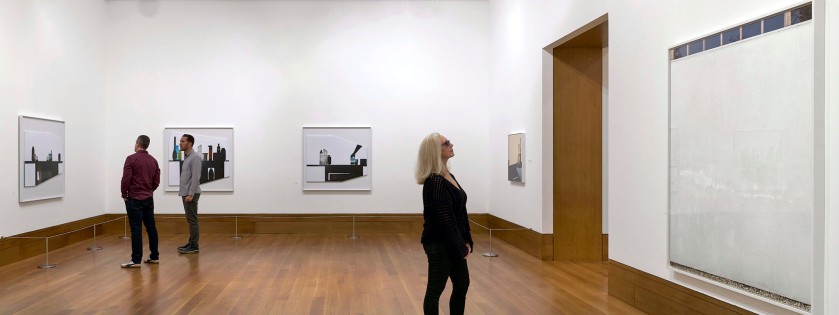









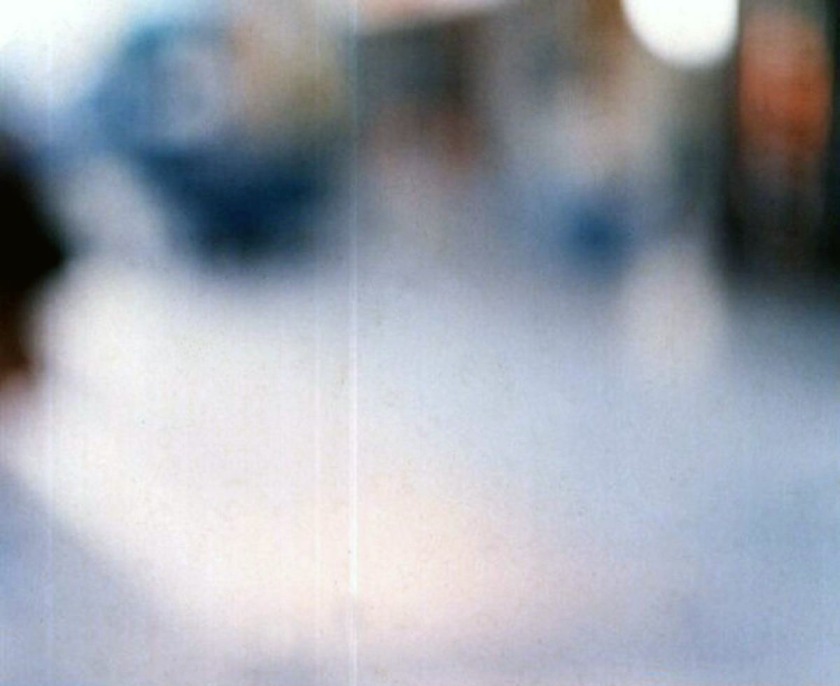

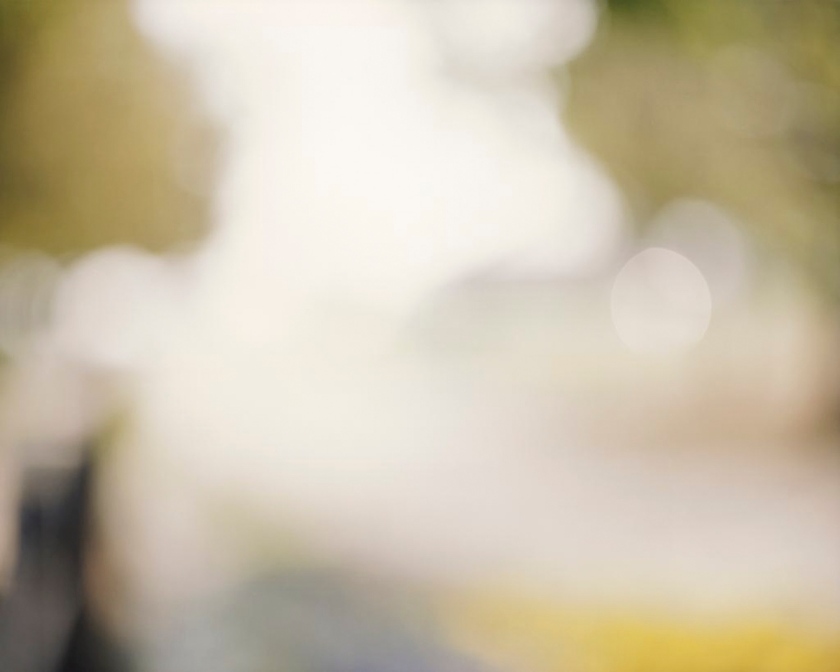
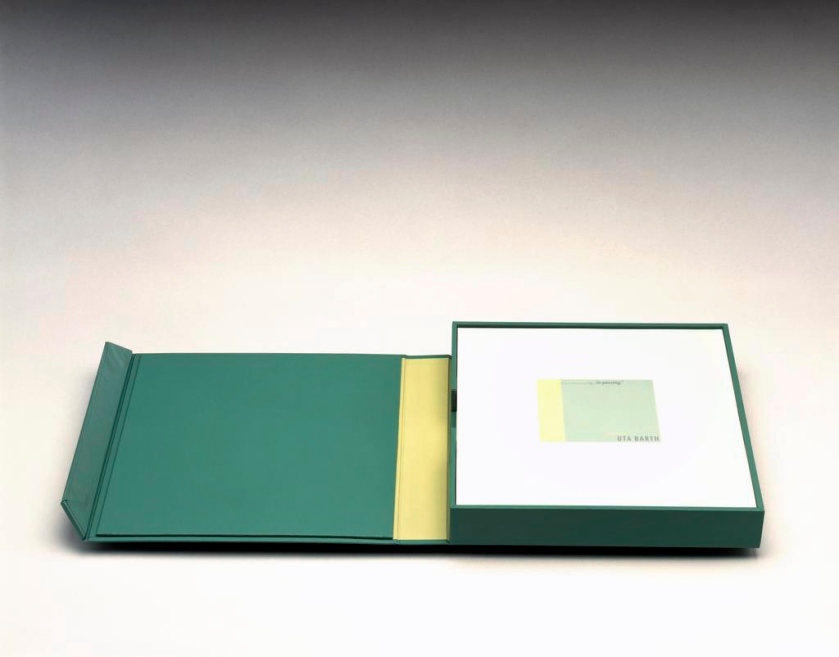





















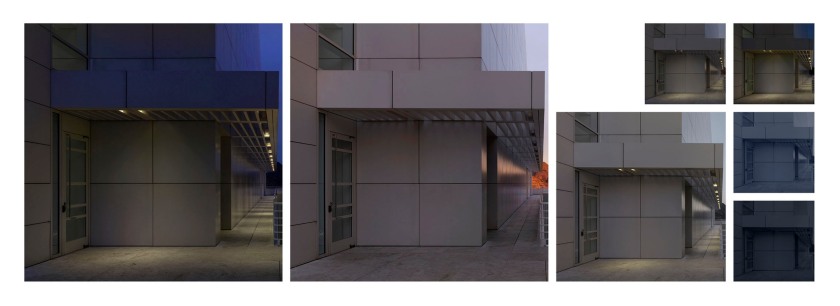
You must be logged in to post a comment.